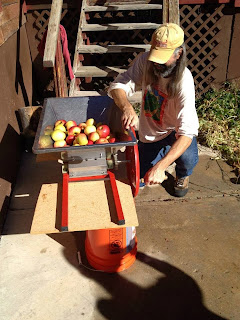Pressing Your Own
If you’d like to step things up a notch and make cider in larger
quantities using your own apples, you’ll need two things: a way to chop up the
apples into smaller pieces, and a press to put the apples into to squeeze out every last bit of juice. Because the equipment
can be costly to purchase, many people just rent them as needed. Local homebrew supply shops are a great place
to check. At around $30-$50 per day, the cost quickly
becomes manageable if you’re making a lot of cider and/or getting a few people
to chip in. In the latter case, you’ve
got the makings for a cider party! My
friend Tara Shupe photographed some cider-making festivities at our friend Lyle
Nay’s house, and she graciously allowed me to use the pictures here.
 |
| 1) The apples are loaded into a grinder which reduces them in size so that they can be fed into the press. |
 |
| 2) The chopped-up fruit is loaded into pressing bags. Originally made from cheesecloth, the bags are now commonly made from a more durable polyester blend. |
 |
3) Cranking the ratcheting handle exerts downward pressure and squeezes out the cider.
4) Liquid gold!
5) Each carboys holds 5 gallons. The yellow one is cider, and the darker one is a wild berry/apple mix.
Building a Down-and-Dirty Cider Press
While I have no problem with renting a cider press, and I'm glad they're available at reasonable rates around here, I couldn't resists a little bit of tinkering to see if I could quickly throw together a functional press with a minimum of effort or expense. The result was the $18 Cider Press. I used one 2x4, and a bottling bucket. At $16, the bucket accounted for most of the cost, but I already had it laying around anyway. I also used the jack from my car. The resulting press wasn't fancy, but it took less than half an hour to build, and just about anyone could do it. The only power tools required are a drill and a jigsaw.
1) I cut the 2x4's and screwed them together with 4" screws. The frame measured 25"x19".
2) I attached the frame to a pair of runners which will serve as the base.
3) I added two more 2x4's to create a platform large enough to hold the bucket.
4) Because the drain is located a couple of inches up the wall of the bucket, I needed to build up the floor
accordingly. I began with a pair of 2x4 spacers.
5) To make a new bottom for the bucket, I cut a 10 1/4" diameter disc from some scrap plywood.
6) The edge of the disc needed to be notched to accommodate the drain.
7) I used a juicer to turn the apples into pulp. You could also use a food mill, food processor, or blender. I didn't have a pressing bag on hand, so I placed the pulp into a cheescloth-like fabric that I had on hand.
8) After gathering the ends of the cloth into a "bag" of sorts, I placed the dripping cloth into the press. I
then set a second plywood disc on top of it.
9) I used an 8" length of 4x4 lumber as a spacer: I just needed a way to wedge the jack in between the
top rail of the frame and the disc, and this worked fine.
10) Ah ha!
|
















Apple cider is a great product. Have you thought of just using the juicer? Here's how: http://makezine.com/projects/kitchen-table-cider-making/
ReplyDelete